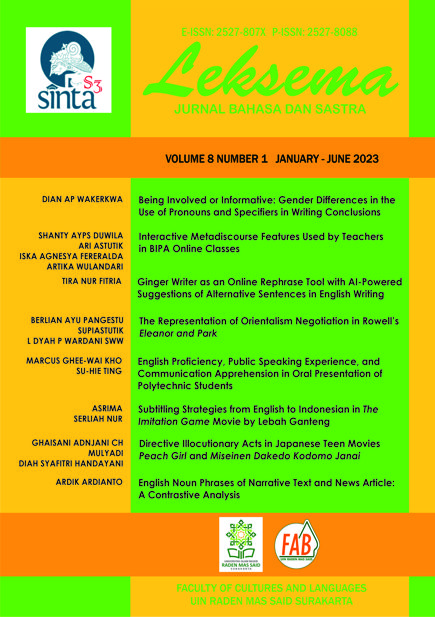BEING INVOLVED OR INFORMATIVE: GENDER DIFFERENCES IN THE USE OF PRONOUNS AND SPECIFIERS IN WRITING CONCLUSIONS
DOI:
https://doi.org/10.22515/ljbs.v8i1.5632Keywords:
conclusion, gender difference, pronoun, scientific writing, specifierAbstract
The conclusion comprises the summary of the study. It is where the authors present their last words about the findings while introducing some suggestions on the issue. Gender is believed to be one of social factors that shapes someone’s communication style, be it oral or written. This study aimed to explore the differences in the use of pronouns and noun specifiers by authors of different genders in composing the conclusions of their research articles. It observed how pronouns and specifiers are manifested differently in the texts and the different intentions behind their use. Ten research articles’ conclusions were randomly selected based on gender of the authors five of each gender from one Indonesian journal in the field of language study. This study is qualitative, thus, the data are analyzed and presented in words to a draw clear interpretation of the issue. The findings revealed the differences in the tendency of female and male authors in utilizing both linguistic features in the conclusions. It was discovered that female authors utilized more pronouns and male authors, on the other hand, used more noun specifiers in their texts.
Downloads
References
Abdurrahman, Nur H. 2017. “An Investigation in Different Language Choice through Personal Pronouns in the Twitter.” Indonesian Journal of Applied Linguistics 2 (1): 1-13.
Alkrisheh, Hazim, and Taisir Alkhrisheh. 2019. “A Study on Gender and Language Differences in English and Arabic Written Texts.” Research and Innovation in Language Learning 2 (2): 120-138.
Argamon, Shlomo, Moshe Koppel, and Anat R. Shimoni. 2003. “Gender, Genre, and Writing Style in Formal Written Texts.” Text 23 (3): 321-346.
Arsyad, Safnil. 2013. “A Genre-Based Analysis on Discussion Section of Research Articles in Indonesian Written by Indonesian Speakers.” International Journal of Linguistics 5 (4): 50-70.
Biber, Douglas. 1995. Dimensions of Register Variation: A Cross-Linguistic Comparison, Cambridge: Cambridge University Press.
Boettger, Ryan K. and Stefanie Wulff. 2019. “Gender Effects in Student Technical and Scientific Writing - A Corpus-Based Study.” IEEE Transactions on Professional Communication 62(3): 239-252.
Fuertes-Olivera, Pedro A. 2007. “A Corpus-Based View of Lexical Gender in Written Business English.” English for Specific Purposes 26: 219-234.
Giles, Howard, Justine Coupland, and Nikolas Coupland. 1991. “Accommodation Theory: Communication Context, and Consequence.” In Howard Giles, Justine Coupland, and Nikolas Coupland (eds). Context of Communication: Studies in Emotion and Social Interaction. 1-68. Cambridge: Cambridge University Press.
Hyland, Ken. 2002. “Options of Identity in Academic Writing.” ELT Journal 56 (4): 351-358.
Hyland, Ken. 2004. “Disciplinary Interaction: Metadiscourse in L2 postgraduate Writing.” Journal of Second Language Writing 13: 133-151.
Ishikawa, Yuka. 2015. “Gender Differences in Vocabulary Use in Essay Writing by University Students.” Procedia 192: 593-600.
Kim, Ha-Kyung, Xiao-meng Yu, Yan-jing Cao, Xiao-ming Liu, and Zhao-ming Huang. 2016. “Dialectal and Gender Differences in Nasalance for a Mandarin Population.” Clinical Linguistics & Phonetics 30 (2): 119-130.
Koppel, Moshe., Shlomo Argamon, and Anat R. Shimoni. 2022. “Automatically Categorizing Written Texts by Author Gender.” Literary and Linguistic Computing 17(4): 401-412.
Kramer, Ruth. 2016. “The Location of Gender Features in the Syntax.” Language and Linguistics Compass 10 (11): 661-677. DOI: https://doi.org/10.1111/lnc3.12226.
Labov, William. 1990. “The Intersection of Sex and Social Class in the Course of Linguistic Change.” Language Variation and Change 2: 205-254.
Lakoff, Robin. 1975. Language and Woman’s Place. New York: Harper and Row.
Llach, María PA. 2010. “Exploring the Role of Gender in Lexical Creations.” In Rosa MJ. Catalán (ed.) Gender Perspectives on Vocabulary in Foreign and Second Languages, 74-92. Hampshire: Palgrave Macmilllan.
Moyer, Alene. 2016. “The Puzzle of Gender Effects in L2 Phonology.” Journal of Second Language Pronunciation 2 (1): 8-18.
Newman, Matthew L., Carla J. Groom, and Lori D. Handelman. 2008. “Gender Differences in Language Use: An Analysis of 14000 Text Samples.” Discourse Processes 45 (3): 211-236.
Seyyedrezaie, Zari S., and Vahideh S. Vahedi. 2017. “Projecting Gender Identity through Metadiscourse Marking: Investigating Writers’ Stance Taking in Written Discourse.” Indonesian Journal of Applied Linguistics 6(2): 301-310.
Su, Yunwen, and Yufen Chang. 2019. “Intra-lingual Pragmatic Variation in Mandarin Chinese Apologies: Influence of Region and Gender.” East Asian Pragmatics 4 (1): 59-86.
Swales, John M., and Christine B. Feak. 2012. Academic Writing for Graduate Students: Essential Tasks and Skills (3rd Edition). Ann Arbor: The University of Michigan Press.
Tannen, Deborah. 1994. Gender and Discourse. Oxford: Oxford University Press.
Waskita, Dana. 2008. “Differences in Men’s and Women’s ESL Academic Writing at the University of Melbourne.” Jurnal Sosioteknologi 14: 448-463.
Downloads
Published
Issue
Section
License
Copyright (c) 2023 Leksema: Jurnal Bahasa dan Sastra

This work is licensed under a Creative Commons Attribution-NonCommercial-ShareAlike 4.0 International License.
The copyright of the received article shall be assigned to the publisher of the journal. The intended copyright includes the right to publish the article in various forms (including reprints). The journal maintains the publishing rights to published articles.
In line with the license, the authors and users (readers or other researchers) are allowed to share and adapt the material only for non-commercial purposes. In addition, the material must be given appropriate credit, provided with a link to the license, and indicated if changes were made. If authors remix, transform or build upon the material, authors must distribute their contributions under the same license as the original.







